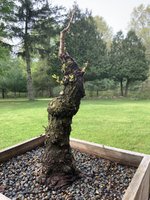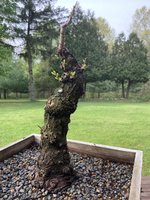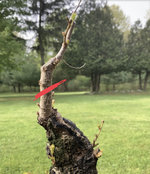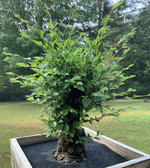Tieball
Masterpiece
One of my American Elms. It is now just starting from the trunk level. It has taken on a few chops down to this size over the last few years. Those chop marks are now rolling over. It’s in a box now and will stay in the box for a few seasons. Maybe forever. I don’t know. It’s good to see plenty of buds developing all over the trunk from very low up to the top. There will be lots of choices in the future. My objective this year is to let new branches grow. Next season the branches will be pruned back significantly. And that should begin to form the development direction of the tree. I don’t yet know the canopy shape that will be developed. I’ll adjust my thinking as the tree develops.
The large chop mark in the middle should roll over and bark up after several seasons. There’s a short story behind that chop.
I may have an extending root to reduce, or eliminate, or keep, next root-pruning season. There are other roots buried so I’ll take a look at the roots all at one time and determine what needs adjustment. It’s possible, with the other roots buried, that this root length is perfectly fine. There is a good fan-out of the roots around the tree.
Right now the trunk diameter at the substrate base is 4.25” (10.80cm). Visible roots not included.
The height from the substrate level trunk base to the highest tip on top is 16” (40.64cm).
The root pad depth is about 2.5” (6.35cm).
The American Elm trees stay outdoors throughout the year. Whatever weather happens.
This tree has a nice rugged look starting.






The large chop mark in the middle should roll over and bark up after several seasons. There’s a short story behind that chop.
I may have an extending root to reduce, or eliminate, or keep, next root-pruning season. There are other roots buried so I’ll take a look at the roots all at one time and determine what needs adjustment. It’s possible, with the other roots buried, that this root length is perfectly fine. There is a good fan-out of the roots around the tree.
Right now the trunk diameter at the substrate base is 4.25” (10.80cm). Visible roots not included.
The height from the substrate level trunk base to the highest tip on top is 16” (40.64cm).
The root pad depth is about 2.5” (6.35cm).
The American Elm trees stay outdoors throughout the year. Whatever weather happens.
This tree has a nice rugged look starting.









